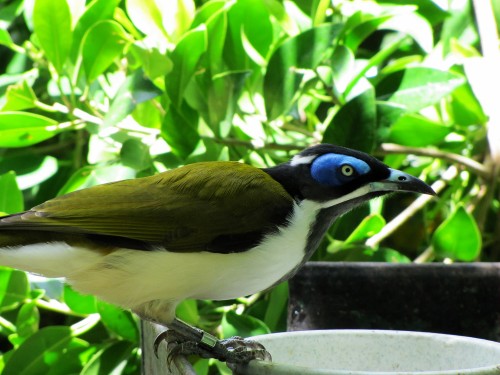Blue-faced Honeyeater, Adelaide Zoo
The first time I focussed my binoculars on a Blue-faced Honeyeater I was amazed at the brightness of its blue face. It was one of those special moments we sometimes get while birding.
As a result of that first great encounter, I enjoy every subsequent observation of this species. On the downside, not every sighting is as good as the one I had earlier this year in one of the walk through aviaries at the Adelaide Zoo here in South Australia. Being a captive bird quite at ease with hundreds of visitors to its home daily, this bird was quite happy to pose for me – or was it just too hungry to fly away. Note the identification band on the right leg.
The Blue-faced Honeyeater is found along coastal northern and eastern Australia, often found far inland from the coast where there is suitable habitat. In south eastern parts of our country it is more of an inland bird, generally avoiding the higher altitudes in Victoria and southern New South Wales.
Its preferred habitats include open forests, watercourses, woodlands, orchards, parks and gardens and farmlands.
For more of my photos of this species and another article click here.
Blue-faced Honeyeater
Australia has many honeyeaters with over sixty different species. I have recorded ten different species in our garden, with all except three being resident breeding species. They are a constant delight as many of them frequently visit the various flowering plants around our property as well as visiting our bird baths many times a day.
One beautiful species that does not visit our garden is the Blue-faced Honeyeater shown in the photos on this page. This is a widespread species across the northern and eastern parts of Australia, except for the extreme south-east. Its preferred habitats include open forests, along water courses, woodlands, parks, gardens, golf courses, farmlands and along roadside vegetation.
The bird shown in these photos was seen in the Hattah-Kulkyne National Park in north-west Victoria while on a brief visit in September 2007.
For additional reading about honeyeaters click here.
Related articles:


